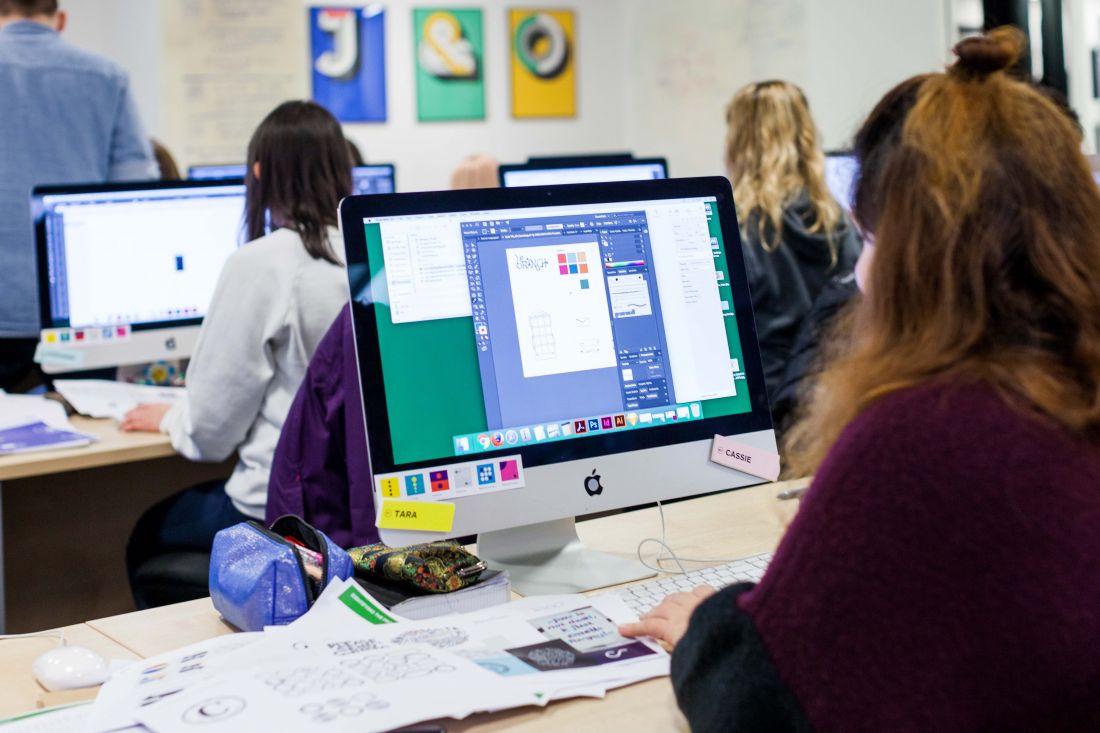Graphic designers create visual concepts that inform, inspire and transform. Use industry-leading tools to create innovative design projects and discover the skills necessary to become a visual thinker and communicator on demand.
Learning graphic design is more than just mastering Photoshop, InDesign and Illustrator. One has to be familiar with the principles of what makes a design successful and that’s something one learns with a 2-year degree or a 4-year college degree. You can be a prodigy with the software, but if you’re fabulous at designing then all your knowledge about the software will only make your amazing designs come out faster. The software is just a mere tool and does not make one a designer.
If you are a complete beginner, it may take a little longer to become a graphic designer because you need to learn more. If you just google it, it wouldn’t be expensive to learn what you can get online for free, as there are better ways to become a graphic designer. You don’t have to pay for it because you can learn as much as you want, even if you’re a full-fledged professional.
There are several different factors that influence how long it takes to become a graphic designer, and there is one important factor that will affect it. One of the important factors that will be affected by how long it takes to become a graphic designer
One of the most important things to consider when thinking about how long it takes to become a graphic designer is potentially the time you devote to learning, learning, and practicing your new skills and knowledge. If you spend all your time learning and applying your latest skills and knowledge, you will be able to become a graphic designer relatively quickly. You should therefore think carefully about how much time you can and want to devote to the profession of a graphic designer. Once you learn how to become a Graphic Designer, you will have a huge career path.
What is Graphic Design?
Graphic design is a visual art form that combines different media styles to make something eye-catching. This field is focused around making appealing visuals that will make people want to look. This can look a little different depend on how you are using your skills. However, the overall idea is that you are making design decisions to create something intended to be shared.
This form of art is being used in many places and many ways. A common use of graphic design is within marketing. It might mean designing a logo for a branding campaign. It could also mean making an infographic to provide customers with important information. The main idea behind in marketing is that it should appeal visually to an audience and likely share important information.
Beyond marketing, graphic design is used in other capacities like web and print layouts. This involves learning where to put everything for a pleasant visual appearance. It also means understanding the way that the information should flow for effectiveness. This might include arranging pictures or designing banners. It’s an incredibly open-ended need.
Time taken in learning Graphic Designing depends on many factors:
- It depends on the person who wants to learn.
- It depends on where you are learning from.
- It depends on the graphic design tools one wants to learn.
- It depends on the experience the person wants to obtain in graphic design.
- It depends on which graphic design file one is learning.
Education Required
Graphic designers use computer technology to produce art work for product packaging, marketing material, websites, newspapers and magazines. If you have strong artistic abilities, good communication skills and have no problems getting to grips with new software systems, the only thing standing between you and a career as a graphic designer will be a few qualifications and some examples of your creativity.
-
High School
As aspiring graphic designers typically need a bachelor’s degree to break into their career of choice, graduating from high school is a prerequisite if you want to enter the industry. While in high school, take as many art and design-related courses as you can. If you have the resources, sign up for a pre-college graphic design course. Attending one of these will prepare you for an undergraduate degree program and could make you a more attractive prospect to the colleges you apply to.
-
College
Degrees in graphic design and fine art are offered widely at colleges, universities and design schools around the country. Some colleges offer Bachelor of Fine Arts in Graphic Design programs. These typically include modules on typography, book design, drawing, advanced graphic design and computer-assisted design, according to Education-Portal.com. If you have a degree in another field and want to become a graphic designer, you can still break into the profession by earning an associate’s degree or a certificate in graphic design.
Few Suggestions to follow when learning Graphic Designing
Get inspiration from anywhere If you are a lover to these design things, it can be assumed that you’re a creative person. Just keep your mind open and pay some your attention to the good-looking things around you such as poster, sale advertise, and recruit promotion. You can also get the inspiration on the internet, there’re some free premium websites especially the Fotor, my favorite one, storing thousands of high quility and free templates. When I am looking for some inspiration at home, it can always give me the suitable design things.
Use no more than 3–4 colors in your design Unless you’re going for a deliberate, full-on rainbow look, avoid combining an excessive amount of colors. Rodrigo German, a Chilean graphic designer, recommends using three colors to keep your graphics looking clean, and not too overwhelming. When using more than three, he suggests adding in textures to tone down some of those additional colors.
Make it concise make sure you’re presenting your information in a clear, clean, and concise way, for any good and beautiful design is in this style. If the work overload too many stickers or fonts, it will cause the confusing and overwhelming feelings.




